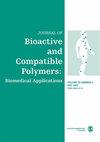用于细胞生长的电纺丝纤维素/SIS-dECM 分层支架
IF 2.1
4区 生物学
Q3 BIOTECHNOLOGY & APPLIED MICROBIOLOGY
引用次数: 0
摘要
生物材料在生物医学应用中发挥着重要作用,它既是组织工程中的支架,也是通过提供结构支撑促进细胞生长的基质。生物材料还能为细胞事件提供信号线索,包括细胞活力、粘附、扩散和功能发展。在这项研究中,我们通过电纺丝(SF)和脱细胞小肠粘膜下细胞外基质(SIS-dECM)制造了一种分层纳米纤维支架。与 SF 纳米纤维基底相比,SIS-dECM 的加入改善了所得到的复合纳米纤维基底的亲水性。通过在 SF 和 SF/SIS-dECM 纳米纤维基底上培养脑膜成纤维细胞,对纳米纤维支架的生物相容性进行了深入研究。细胞活力、增殖、灶粘附和细胞粘附相关基因表达水平的定量测量结果表明,添加 SIS-dECM 有利于成纤维细胞的粘附和扩散。因此,SF/SIS-dECM 纳米纤维为细胞生长提供了合适的基底,本研究表明纳米纤维基底在生物应用方面具有很大的潜力。本文章由计算机程序翻译,如有差异,请以英文原文为准。
Electrospun silk fibroin/SIS-dECM hierarchical scaffolds for cell growth
Biomaterials play an important role in biomedical applications serving as scaffolds in tissue engineering and substrates for cell growth by providing structural supports. Signaling cues for cellular events can be also presented, including cell viability, adhesion, spreading, and function developments. In this study, we fabricated a hierarchical nanofibrous scaffold through electrospinning silk fibroin (SF) and decellularized extracellular matrix of the small intestine submucosa (SIS-dECM). The addition of SIS-dECM improved the hydrophilic features of the resultant composite nanofibrous substrates as compared to SF nanofibrous substrates. The biocompatibility of the nanofibrous scaffolds was thoroughly investigated by culturing meningeal fibroblasts on SF and SF/SIS-dECM nanofibrous substrates. Cell viability, proliferation, focal adhesion, and quantitative measurements of cell adhesion-related gene expression levels revealed that the addition of SIS-dECM favored the adhesion and spreading of fibroblast cells. Therefore, the SF/SIS-dECM nanofibers provided a suitable substrate for cell growth and the present study suggested that the nanofibrous substrates hold high potential for bioapplications.
求助全文
通过发布文献求助,成功后即可免费获取论文全文。
去求助
来源期刊

Journal of Bioactive and Compatible Polymers
工程技术-材料科学:生物材料
CiteScore
3.50
自引率
0.00%
发文量
27
审稿时长
2 months
期刊介绍:
The use and importance of biomedical polymers, especially in pharmacology, is growing rapidly. The Journal of Bioactive and Compatible Polymers is a fully peer-reviewed scholarly journal that provides biomedical polymer scientists and researchers with new information on important advances in this field. Examples of specific areas of interest to the journal include: polymeric drugs and drug design; polymeric functionalization and structures related to biological activity or compatibility; natural polymer modification to achieve specific biological activity or compatibility; enzyme modelling by polymers; membranes for biological use; liposome stabilization and cell modeling. This journal is a member of the Committee on Publication Ethics (COPE).
 求助内容:
求助内容: 应助结果提醒方式:
应助结果提醒方式:


